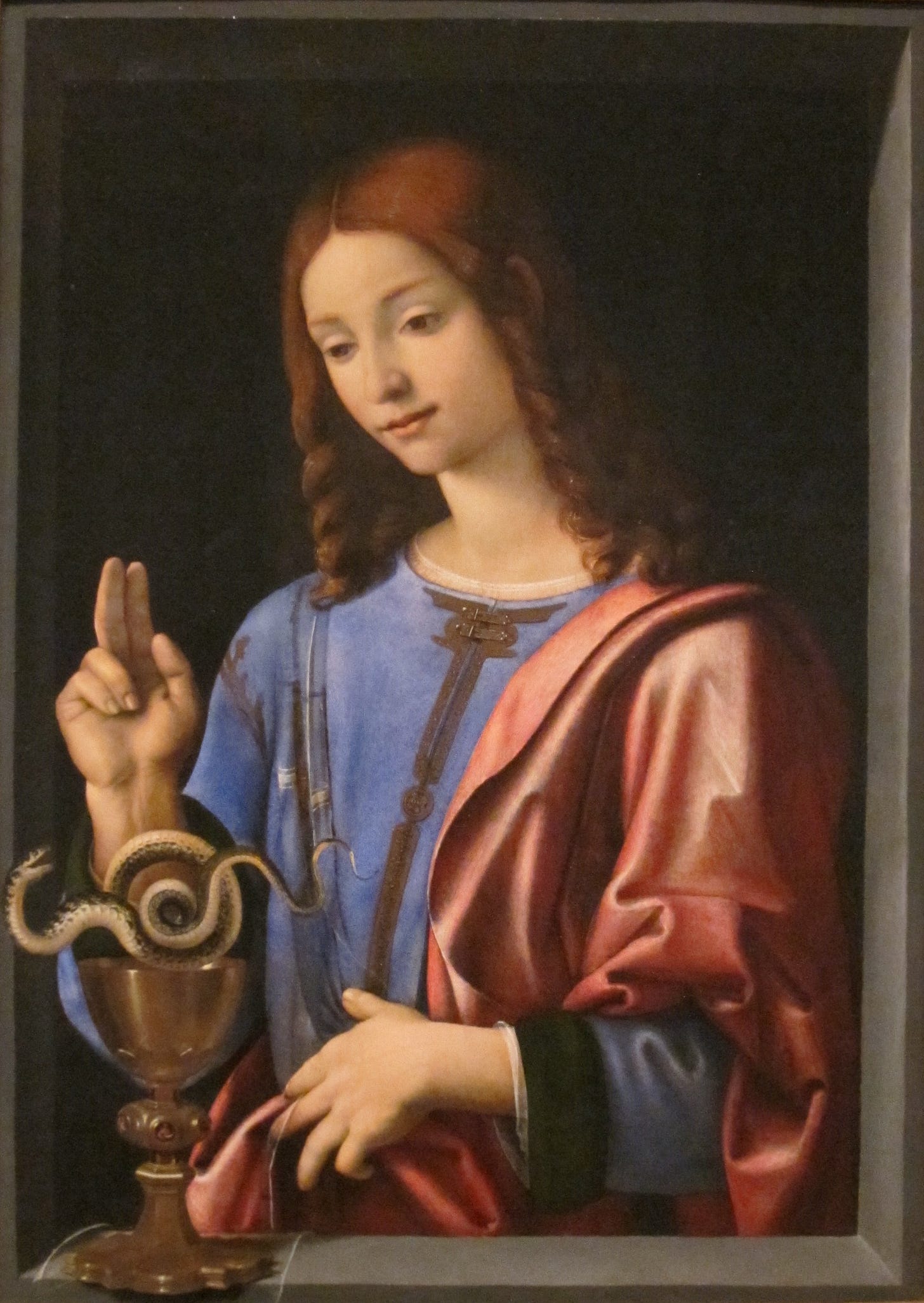Now Peter and John
were going up to the temple
at the hour of prayer,
the ninth hour.
Acts 3:1.

John is an enigmatic figure in Acts of the Apostles, which is fitting for the author of the most theologically sublime Gospel. In some Catholic mystical literature, Peter and John tend to be viewed as complimentary figures: John representing the head (thought, meditation, interiority) and Peter representing the heart (action, preaching, exteriority).
John the Beloved is depicted as calm and collected, not fleeing from the crucifixion, worthy to be a surrogate son to the Mother of God, comfortably resting on the bosom of the Lord.
Peter, on the other hand, is the one who draws his sword to cut off the ear of Malchus. He is praised for declaring Jesus the Christ, and in the next breath vilified as Satan for denying the necessity of the crucifixion. He’s impulsive to a fault, only gaining a sense of mission and composure after the Ascension and Pentecost.
The two are paired in most mentions in Acts of the Apostles:
John is present with the others after the Ascension.
Peter and John are on their way to the temple together at the hour prayer when Peter heals the man lame from birth. (Acts 3) This tells us that they traveled together and continued to observe the Jewish temple worship. The incident, in which Peter is the active figure, emphasizes the secondary role of John as the Beloved.
In Chapter 4, John is with Peter when they are questioned by the assembly of the Sanhedrin. We are told that “Peter and John answered them” (Acts 4:19), but it is clear that Peter is the one speaking for both.
In Acts 8:14, Peter and John encounter Simon Magus.
And then John is gone from Acts of the Apostles, never having spoken a word. (The “John” referred to in the second half of the book is John-Mark, not The Beloved.)
What are we to make of this silence of John?
Certainly, we can’t assume it speaks to his irrelevance, or he wouldn’t have appeared with Peter at all the crucial moments. To Peter was left the role of speaking, but John was, as Paul tells us Galatians 2:9, a ”pillar” of the Church in Jerusalem. We can assume he attended the Council of Jerusalem and was an integral part of all the decision making.
Yet John, in Acts, holds back and lets Peter go first. John was a young man, Peter was older. Peter had a successful fishing business in partnership with the family of Zebedee, including John and his brother, James. Given John’s youth and the authority Peter displays when we find him fishing, we can assume Peter was, if not the boss, at least the senior partner.
John reaches the empty tomb first, but waits for Peter to enter. (John 20:7). John sees the risen Christ on the shore first, but it is Peter who leaps in water and swims to shore. (John 21:7) Peter, not John, asks what will be the fate of John. (John 21:20)
In all things, John yielded to the leadership and authority of Peter.
And yet … it is John whose marvelous poetry lays the foundation of the elevated Christology of the Church. The Eastern Churches refer to him simply as The Theologian: “one who can speak in accessible terms of the divine, revealing an arcane access to God through attachment to Jesus.” (Pope Benedict XVI, The Apostles) In his meditation on John, Pope Benedict cites a tradition recorded in the apocryphal Acts of John. It depicts the Beloved not as a leader or founder of churches (as were Peter and Paul) but as “a perpetual wayfarer, a communicator of the faith in the encounter with ‘souls capable of hoping and of being saved.’” (See Acts of John 18:10 and 23:8.)
John’s Gospel is the result of long, deep, meditation on the the Jesus he knew and the things he witnessed. In Acts, we see John young, quiet, thoughtful, listening, following, internalizing.
The silence of John is the very silence that allows him to hear the Spirit singing into his soul the words that will reshape our understanding of the origins and composition of everything: “In the beginning was the Word, and the Word was with God, and the Word was God.”
Acts shows us the John who heard this truth, but it doesn’t let us hear him. His presence with Peter indicates his authority. His silence indicates his unique wisdom. As the Psalmist says, “Be still before the Lord and wait patiently for him.” (Psalm 37:7)
John was patient. He may have waited a full 50 years after the incidents described in Acts before setting down his Gospel. It was a silence that produced wonders. Like John, may we all turn to silence and listen to the still small voice calling to us.



